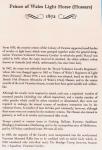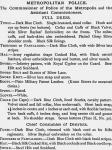-
Posts
1,761 -
Joined
-
Last visited
-
Days Won
3
Content Type
Profiles
Forums
Blogs
Gallery
Events
Store
Everything posted by Stuart Bates
-
Mervyn, the Royal Navy did not sport plumes in their cocked hats and the loop was of twisted bullion interspersed with buttons. The blue feathers do tend towards police, having ruled out the Royal Navy. And it is not a Lord Lieutenant's etc. because of that navy blue. And the same applies to diplomatic people. Did/do mayors etc. wear a cocked hat with plume? Stuart
-
I was prompted to start this thread by Brett's thread on the S.A. Navy and its origins. I am no authority on Australian Colonial Forces but thought that I could at least initiate the subject's discussion and for others more knowledgeable to follow. When Australia was settled in 1788 by the British, units of the Regular British Army provided a garrison and performed such duties as guarding convicts, maintaining civil law and order and providing protection from foreign interference. The posting was not popular with the troops because of the inherent boredom, the climate and the sheer distance from their homes and fellow regiments. The British Government, always with an eye to costs, soon began to pressure the various Colonial Governments to raise Volunteer forces which would assume responsibility for their own defence. These forces were raised in 1854 in Victoria, New South Wales and South Australia. They were followed by Volunteer forces in Tasmania 1859, Queensland in 1860 and Western Australia in 1861. Volunteer forces generally fashioned themselves on British Army lines. Some of these men saw service in the British Army during the Maori Wars, and in 1885 a contingent from New South Wales went to the Sudan. In 1870 the British Regulars left Australia and the Volunteers were supported by permanent forces, but in the mid 1880s permanent Militia forces were formed which received payment for service. In 1901, with Federation, control of all Australian forces passed to the Commonwealth of Australia. Uniforms were closely modelled on their British counterparts with Hussars, Lancers, Horse Artillery and infantry resplendent in scarlet or blue tunics and trousers of blue, brown, gray and rifle green. Headgear included Busbies, plumed helmets, British Home Service helmets, white Colonial pattern helmets with and without puggarees and with helmet plates. It is interesting to note that these white Colonial helmets had both the spike and dome fitting and spike with the Home Service helmet crosspiece depending on the regiment. Stuart Here is a photo of the Adelaide Lancers and note the hogspear spike to the helmets.
-
Brett, a wonderful thread. I had no knowledge of the SA Navy (provincial or national) until I read this. The medals are excellent, especially the 1906 rebellion ones. But I am a complete novice in the area of medals and medal collecting. I was amused by your comment "Winston Churchill, who had won a measure of fame in Natal during the Anglo-Boer War..." Surely one of the great understatements concerning the 2nd Boer War I look forward to your further contributions. Best regards, Stuart
-
Mervyn, you make some good points and for me the killer as for its being military are the navy blue feathers. As far as I can tell only the following combinations were used - white over redred over whitewhite over black (Army Ordnance)black (Army Medical Services)white over yellow (Army Pay Department)red (Army Veterinary Department)black over white (Provost Marshal and Military Mounted Police) Stuart
-
Hello Peter, if it hasn't been said before then welcome to GMIC. The fact that the RIC adopted the peaked/German/Staff cap in 1900 indicates that it was assuredly in use, unofficially, some years before that date. The beauty of this forum is that these snippets of information come together to help us all form a more rounded picture of a given subject. I have said it before but better to have a group of knowledgeable people than one expert. Cheers, Stuart
-
Hi Mervyn, I also thought it was a dragon on the button but not only was it too indistinct for me to posit that. If it is then the 14th Hussars, but as far as I can tell Hussars did not have cocked hats. This whole area is confusing in the Dress Regs. There is a lot of jargon which simply escapes me Red tassles indicate a Field Marshal, General, Colonel and just about everybody else who was a staff officer. I do know that the Army Pay Department had blue tassles under the gold bullion but that's the only variation I have found so far. The major difference seems to be the "lace" used on the loop which was worn on the right hand side of the hat. The button would appear to be the key. Stuart
-
Well I can't locate the pattern on the trimming of the hat but the plume would appear to be white over red feathers and 6" long. This length indicates an officer under the rank of Colonel. Field Marshalls, Generals had a 10" plume whilst Colonels had 8". It would seem that cocked hats were worn by General Staff or Regimental/Corps staff officers. Can we get a better i.e. closeup of the button as it does not appear to be the bullion purl button used on the higher ranks cocked hats. I have two: one to the Royal Engineers and the other to the Welsh Guards and each button contains a device which indicates their corps or regiment. The name on the plate is a little difficult to read but is it Major Campbell? Now that doesn't make it easy Stuart
-

HMS Barham
Stuart Bates replied to Stuart Bates's topic in Great Britain: Research, Documentation & History
Brett, I don't see that your posting here would be unethical. We do it all the time to a greater or lesser degree. Cheers, Stuart -

HMS Barham
Stuart Bates replied to Stuart Bates's topic in Great Britain: Research, Documentation & History
Brett, that information sounds like it should initiate a thread on the SA Navy and its beginnings. I have always had a liking for naval ships and built the USS New Jersey, the Hood and the PT109 all of which I have still here in my study. I also built, and I mean built, the PT109 as an RC model about 3' long but I was talked into buying an overpowered motor such that it sits so low in the water that it hardly stays afloat, Off topic I know but that's what we do Cheers, Stuart -

HMS Barham
Stuart Bates replied to Stuart Bates's topic in Great Britain: Research, Documentation & History
It has been a lazy Saturday afternoon so I watched the ABC/BBC production The Battleships which is excellent and charts the course of the battleship from its beginnings - canvas to steam, timber to steel etc. And yes it does include the HMS Barham but in context. A quite brilliant production. However, I must compare it to another DVD called Battleships at War which allocates about 19 minutes to the evolution/rest of the world and the remaining 36 minutes to the US battleships. Sorry to our US members but not good enough. I was incensed enough to write a critique but then found that there was no one to send it to oh well, such is life. Stuart -

HMS Barham
Stuart Bates replied to Stuart Bates's topic in Great Britain: Research, Documentation & History
Brett, I wonder how many other nationalities were seconded to the Royal Navy. Quite a few I would think. Stuart








